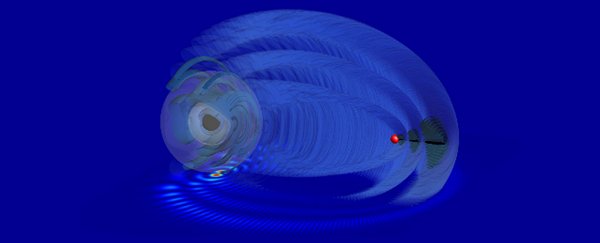Can you really create a chemical bond with one atom rather than the regular two? It sounds as though it would go against the laws of science – like a single hand clapping – but scientists think they may have found a way of doing it.
The approach centres around Rydberg atoms - they contain a single electron in a highly excited state. These atoms are usually seen as one half of special types of two-atom bonds, so-called trilobite molecules that are particularly large because of the spaced-out path of that busy electron.
The distant electron orbit that is key to large trilobite molecules might also enable Rydberg hydrogen atoms to 'bond' with a point in empty space, new research suggests.
That bond with literal nothingness would be extremely brief - but it could open up a new method of altering many chemical reactions.
"We predict it would live for several hundred microseconds, or even longer in a cold environment," one of the researchers, Matthew Eiles from Purdue University in Indiana, told Andy Coghlan at New Scientist.
Eiles and his team describe the new bonds as "ghost bonds" – the lone, excited electron essentially gets tricked into getting fixed into the same position as it would be if a second atom were present.
This could be done by firing an alternating sequence of electric and magnetic pulses at the atom, keeping the electron dozens of nanometres away from the nucleus.
For now though, this is all just a hypothesis: the researchers haven't actually achieved any ghost bonding, but they have run the maths and calculated the models that suggest it could well be possible in the lab.
"I think it could actually be done," Johannes Wilhelm Deiglmayr, from the Swiss Federal Institute of Technology in Zurich, told New Scientist. "This would be really fun to see."
Deiglmayr was part of the team that first developed super-elongated Rydberg atoms a couple of years ago. These special atoms, measuring a micrometre in size (about a thousand times larger than normal), are what might make ghost bonding possible.
Further down the line, the researchers think "even more exotic" ghost states might be possible through the careful manipulation of Rydberg atoms. It could even have a use in the field of quantum mechanics, in the creation of quantum gates for example – a basic quantum circuit.
And anything that alters how chemical reactions work on a fundamental level – from using light to create and destroy them, to creating bonds with a single atom – has the potential to open up a whole host of new possibilities.
As far as the hypothesis is concerned, the numbers add up – we might soon be seeing chemical bonds that use one atom rather than two. The next step is to actually figure out how to achieve it in a real lab experiment.
"As simple theorists, we'll leave this challenge to the experts, the experimentalists," Eiles told New Scientist.
The research has been published in Physical Review Letters.
